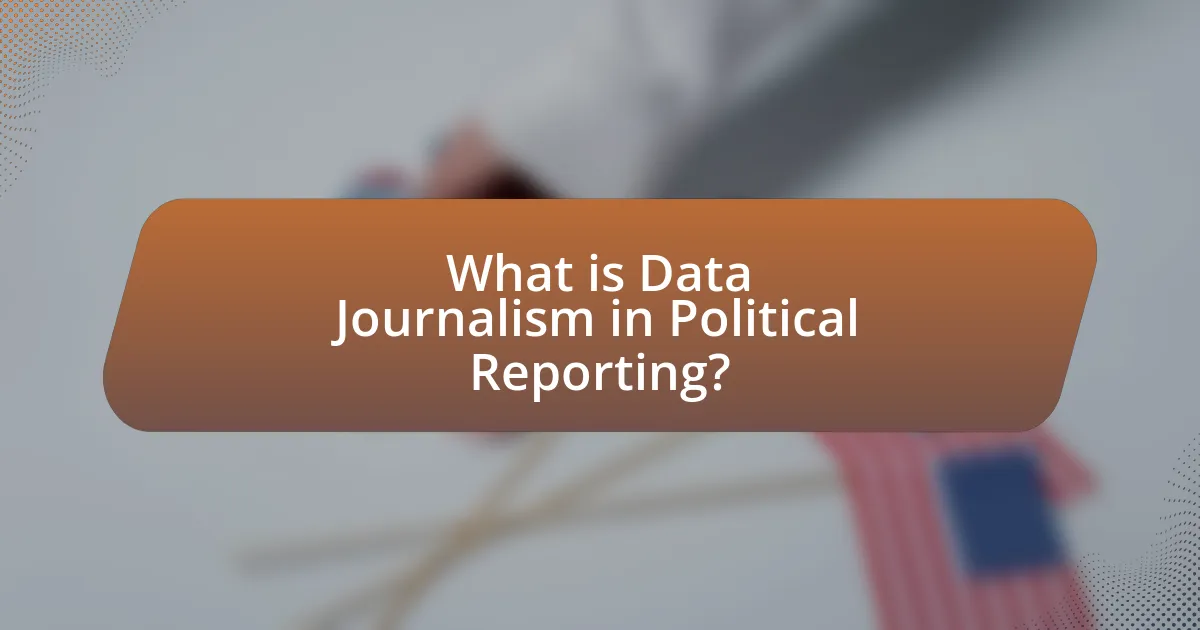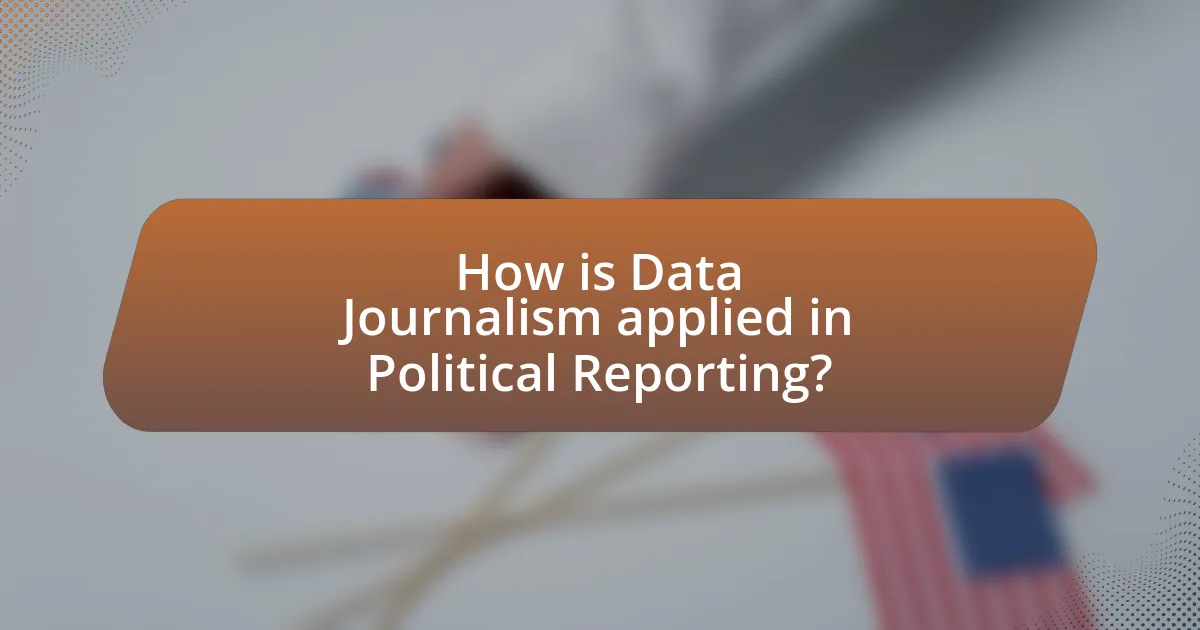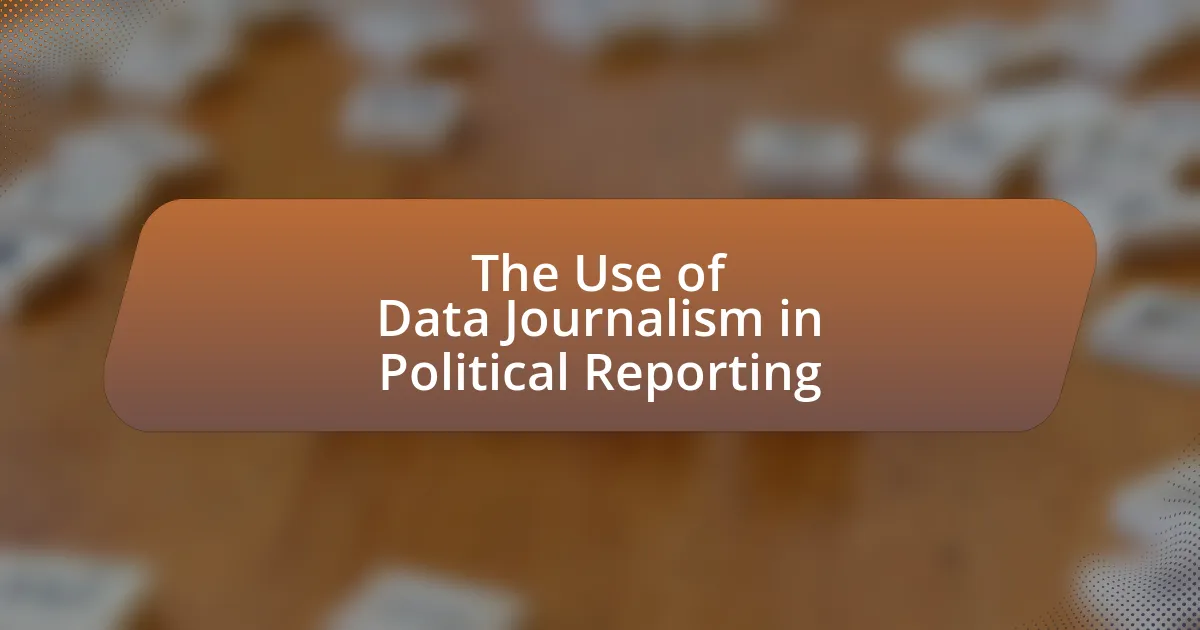Data journalism in political reporting is the integration of data analysis and visualization techniques to enhance the coverage of political issues. This approach allows journalists to uncover trends and insights from large datasets, improving the accuracy and depth of reporting compared to traditional methods. Key characteristics of data journalism include data-driven storytelling, transparency in methodology, and a focus on accuracy, which collectively enhance public understanding and accountability in governance. The article also explores the tools and techniques used in data journalism, notable examples of its application, and the challenges and ethical considerations faced by journalists in this evolving field.

What is Data Journalism in Political Reporting?
Data journalism in political reporting is the practice of using data analysis and visualization to inform and enhance political news coverage. This approach allows journalists to uncover trends, patterns, and insights from large datasets, which can lead to more informed reporting on political issues. For instance, the use of data from sources like the U.S. Census Bureau or election results can provide context and depth to stories about demographic changes or voting behavior. By integrating quantitative evidence into their narratives, data journalists can present a more accurate and compelling picture of political landscapes, thereby improving public understanding of complex issues.
How does Data Journalism differ from traditional journalism?
Data journalism differs from traditional journalism primarily in its reliance on data analysis to uncover stories, rather than solely on interviews and observations. While traditional journalism often focuses on narrative and qualitative reporting, data journalism emphasizes quantitative data, using statistical methods and data visualization to present findings. For instance, a data journalist might analyze large datasets from government sources to reveal trends in voter behavior, whereas a traditional journalist might report on election outcomes based on interviews with candidates and voters. This approach allows data journalism to provide deeper insights and support claims with empirical evidence, enhancing the credibility and depth of political reporting.
What are the key characteristics of Data Journalism?
Data journalism is characterized by its reliance on data analysis to tell stories and uncover insights. This approach emphasizes the use of quantitative data, often sourced from public records, surveys, or databases, to support journalistic narratives. Key characteristics include data-driven storytelling, which integrates visualizations and infographics to enhance understanding; transparency in methodology, allowing audiences to see how data was collected and analyzed; and a focus on accuracy, ensuring that data is verified and contextualized. For instance, a study by the Tow Center for Digital Journalism highlights that data journalism can reveal patterns in political behavior, making it a powerful tool for investigative reporting.
Why is Data Journalism important in the context of political reporting?
Data journalism is important in the context of political reporting because it enhances transparency and accountability in governance. By utilizing data analysis, journalists can uncover patterns, trends, and anomalies in political behavior, such as voting records or campaign financing. For instance, a study by the Pew Research Center found that data-driven investigations can reveal discrepancies in public statements made by politicians, thereby informing the electorate and fostering informed decision-making. This reliance on empirical evidence strengthens the credibility of political reporting and empowers citizens to engage more critically with political processes.
What role does Data Journalism play in enhancing political transparency?
Data journalism plays a crucial role in enhancing political transparency by providing data-driven insights that expose government actions and hold officials accountable. By analyzing large datasets, journalists can uncover patterns of corruption, inefficiency, and policy impacts that may not be visible through traditional reporting methods. For instance, investigations like the Panama Papers utilized data journalism to reveal hidden financial dealings of politicians, leading to public outcry and policy changes in multiple countries. This demonstrates how data journalism not only informs the public but also fosters a culture of accountability in governance.
How does Data Journalism help uncover political corruption?
Data journalism helps uncover political corruption by analyzing large datasets to identify patterns, discrepancies, and anomalies that suggest unethical behavior. For instance, investigative reports often utilize public records, financial disclosures, and voting data to reveal conflicts of interest or illicit financial transactions. A notable example is the Panama Papers investigation, where data journalism exposed the offshore financial dealings of numerous politicians, leading to significant political fallout and reforms in various countries. This methodical approach allows journalists to present concrete evidence of corruption, making it more difficult for corrupt practices to go unnoticed.
What impact does Data Journalism have on public trust in political institutions?
Data journalism positively impacts public trust in political institutions by providing transparent, data-driven insights that enhance accountability. When journalists utilize data to uncover facts and trends, they empower citizens with information that can challenge misinformation and promote informed decision-making. For instance, a study by the Pew Research Center found that 63% of Americans believe that data journalism helps them better understand complex issues, thereby increasing their trust in the media and, by extension, political institutions. This trust is further reinforced when data journalism highlights government performance metrics, enabling the public to hold officials accountable for their actions.

How is Data Journalism applied in Political Reporting?
Data journalism is applied in political reporting by utilizing quantitative data to analyze and present information about political events, trends, and policies. This approach enables journalists to uncover insights that may not be immediately apparent through traditional reporting methods. For instance, data journalism can involve analyzing voting patterns, campaign finance records, or public opinion surveys to provide a clearer picture of electoral dynamics. A notable example is the use of data visualization in the reporting of election results, where graphical representations of data help audiences understand complex information quickly. Additionally, studies have shown that data-driven stories can enhance transparency and accountability in politics, as evidenced by investigations that reveal discrepancies in government spending or highlight the impact of legislation on different demographics.
What tools and techniques are commonly used in Data Journalism?
Data journalism commonly employs tools such as spreadsheets, data visualization software, and programming languages. Spreadsheets like Microsoft Excel and Google Sheets are essential for data organization and analysis, allowing journalists to manipulate large datasets efficiently. Data visualization tools, such as Tableau and Infogram, help in creating compelling visual representations of data, making complex information more accessible to the audience. Additionally, programming languages like Python and R are frequently used for data scraping, statistical analysis, and automating repetitive tasks, enhancing the depth and accuracy of reporting. These tools and techniques enable journalists to uncover insights and present data-driven narratives effectively in political reporting.
How do data visualization tools enhance political reporting?
Data visualization tools enhance political reporting by transforming complex data into accessible visual formats, allowing journalists to convey information more effectively. These tools enable the presentation of trends, comparisons, and patterns that might be obscured in raw data, facilitating a clearer understanding of political issues. For instance, a study by the Pew Research Center found that articles incorporating data visualizations are more likely to engage readers and improve comprehension, as visuals can simplify intricate datasets and highlight key insights. This capability not only aids in storytelling but also fosters transparency and accountability in political reporting by making data-driven narratives more digestible for the public.
What statistical methods are frequently employed in political data analysis?
Statistical methods frequently employed in political data analysis include regression analysis, hypothesis testing, and descriptive statistics. Regression analysis, particularly logistic regression, is used to model the relationship between variables, such as voter behavior and demographic factors. Hypothesis testing allows researchers to determine the significance of their findings, often using p-values to assess the likelihood that results are due to chance. Descriptive statistics summarize data sets, providing insights into trends and patterns, such as voter turnout rates or public opinion polls. These methods are essential for making informed decisions and predictions in political contexts, as evidenced by their widespread application in studies published in journals like the American Political Science Review.
What are some notable examples of Data Journalism in political reporting?
Notable examples of data journalism in political reporting include The New York Times’ analysis of the 2020 U.S. presidential election, which utilized interactive maps and data visualizations to illustrate voting patterns and demographic shifts. Another significant instance is FiveThirtyEight’s statistical modeling of election outcomes, which provided probabilistic forecasts based on extensive data analysis. Additionally, The Guardian’s “The Counted” project documented police killings in the U.S. through comprehensive data collection and visualization, highlighting systemic issues in law enforcement. These examples demonstrate how data journalism enhances political reporting by providing clear, evidence-based insights into complex issues.
How did specific investigations utilize Data Journalism to reveal political issues?
Specific investigations utilized Data Journalism to reveal political issues by analyzing large datasets to uncover patterns of corruption and misconduct. For instance, the Panama Papers investigation employed data journalism techniques to sift through 11.5 million documents, revealing how powerful figures used offshore accounts to evade taxes and launder money. This analysis not only highlighted individual cases of financial impropriety but also exposed systemic issues within global financial systems, prompting international discussions on tax reform and accountability. The use of data visualization tools further enhanced public understanding of these complex issues, making the findings accessible and impactful.
What lessons can be learned from successful Data Journalism projects in politics?
Successful Data Journalism projects in politics demonstrate the importance of transparency, accuracy, and audience engagement. These projects often reveal how data can uncover hidden patterns in political behavior, such as voting trends or campaign financing, which enhances public understanding of complex issues. For instance, the “ProPublica’s Electionland” project effectively used data to track voter suppression during elections, showcasing how data can empower citizens and hold authorities accountable. Additionally, successful projects emphasize the need for collaboration between journalists and data scientists, as seen in the “Guardian’s Data Blog,” which combines expertise to produce insightful analyses. These lessons highlight that effective data journalism not only informs the public but also fosters a more informed electorate.

What challenges does Data Journalism face in Political Reporting?
Data journalism faces several challenges in political reporting, primarily including data accessibility, data interpretation, and bias in data presentation. Data accessibility is a significant hurdle, as journalists often struggle to obtain reliable and comprehensive datasets from government sources or private entities, which can hinder thorough analysis. For instance, a study by the Tow Center for Digital Journalism highlights that many public datasets are incomplete or poorly maintained, making it difficult for journalists to draw accurate conclusions.
Data interpretation poses another challenge, as journalists must possess the necessary skills to analyze complex datasets effectively. Misinterpretation can lead to misleading narratives, which can skew public perception. According to a report from the Reuters Institute for the Study of Journalism, a lack of statistical literacy among journalists can result in errors that undermine the credibility of their reporting.
Lastly, bias in data presentation can distort the information conveyed to the audience. Journalists may unintentionally emphasize certain data points while neglecting others, leading to a skewed representation of political issues. Research from the American Press Institute indicates that framing effects can significantly influence how audiences perceive political information, underscoring the importance of balanced data reporting.
What are the ethical considerations in Data Journalism?
Ethical considerations in data journalism include accuracy, transparency, privacy, and accountability. Accuracy is crucial as data journalists must ensure that the information presented is correct and not misleading; for instance, misrepresenting statistics can lead to public misinformation. Transparency involves clearly communicating the sources of data and the methods used for analysis, which builds trust with the audience. Privacy concerns arise when handling personal data, necessitating adherence to legal standards such as GDPR to protect individuals’ rights. Accountability requires journalists to take responsibility for their reporting, including correcting errors and addressing any potential harm caused by their work. These considerations are essential for maintaining credibility and ethical standards in political reporting, where the impact of data-driven narratives can significantly influence public opinion and policy.
How can journalists ensure accuracy and integrity in data reporting?
Journalists can ensure accuracy and integrity in data reporting by rigorously verifying data sources and employing fact-checking methods. This involves cross-referencing information from multiple credible sources, such as government databases, academic studies, and reputable news organizations. For instance, a study by the Pew Research Center found that 64% of journalists prioritize source verification to maintain credibility. Additionally, journalists should utilize statistical tools and software to analyze data accurately, ensuring that interpretations are based on sound methodologies. By adhering to these practices, journalists can uphold the standards of accuracy and integrity essential in data journalism, particularly in the context of political reporting.
What are the potential biases in data collection and analysis?
Potential biases in data collection and analysis include selection bias, measurement bias, and confirmation bias. Selection bias occurs when the sample collected is not representative of the population, leading to skewed results; for example, if a survey only includes responses from a specific demographic, it may not reflect the views of the entire population. Measurement bias arises when the tools or methods used to collect data are flawed, such as using poorly designed survey questions that lead respondents toward a particular answer. Confirmation bias happens when analysts favor information that confirms their pre-existing beliefs or hypotheses, potentially ignoring contradictory data. These biases can significantly impact the validity of findings in political reporting, as evidenced by studies showing that biased data can lead to misinterpretations of public opinion and policy effectiveness.
How does the evolving technology impact Data Journalism in politics?
Evolving technology significantly enhances data journalism in politics by enabling more efficient data collection, analysis, and visualization. Advanced tools such as machine learning algorithms and big data analytics allow journalists to process vast amounts of information quickly, uncovering trends and insights that were previously difficult to identify. For instance, the use of natural language processing can analyze public sentiment from social media data, providing real-time insights into voter opinions and political trends. Additionally, interactive data visualizations created with software like Tableau or D3.js help present complex information in an accessible format, making it easier for the public to understand political issues. This technological evolution not only improves the accuracy and depth of political reporting but also increases audience engagement by making data-driven stories more compelling and understandable.
What are the implications of artificial intelligence on political data analysis?
Artificial intelligence significantly enhances political data analysis by enabling more accurate predictions and insights from large datasets. AI algorithms can process vast amounts of political data, such as voter behavior, social media sentiment, and demographic trends, leading to more informed decision-making. For instance, during the 2020 U.S. presidential election, AI-driven analytics helped campaigns tailor their messaging based on real-time data, improving voter engagement. Additionally, AI tools can identify patterns and correlations that human analysts might overlook, thereby increasing the depth of analysis. This capability is supported by studies showing that AI can improve predictive accuracy in political forecasting by up to 20%, demonstrating its transformative impact on the field.
How can journalists adapt to the rapid changes in data technology?
Journalists can adapt to the rapid changes in data technology by continuously updating their skills in data analysis and visualization tools. This adaptation is essential as the media landscape increasingly relies on data-driven storytelling to engage audiences and provide in-depth political reporting. For instance, a 2021 study by the Pew Research Center found that 63% of journalists reported using data in their reporting, highlighting the growing importance of data literacy in the field. By participating in training programs, utilizing online resources, and collaborating with data scientists, journalists can enhance their ability to interpret complex datasets and present them effectively to the public.
What best practices should journalists follow when using Data Journalism in political reporting?
Journalists should prioritize accuracy, transparency, and context when using data journalism in political reporting. Accuracy involves verifying data sources and ensuring that statistics are correctly interpreted; for instance, a study by the Pew Research Center found that misrepresentation of data can lead to public misinformation. Transparency requires journalists to disclose their data sources and methodologies, allowing audiences to understand how conclusions were drawn. Context is crucial, as presenting data without relevant background can mislead readers; for example, a report on voter turnout should include historical comparisons to provide a clearer picture. By adhering to these best practices, journalists can enhance the credibility and impact of their political reporting.
How can journalists effectively communicate complex data to the public?
Journalists can effectively communicate complex data to the public by simplifying the information through clear visuals, concise language, and relatable context. Utilizing infographics and charts allows audiences to grasp intricate data quickly, while avoiding jargon ensures that the language remains accessible. For instance, a study by the Pew Research Center found that visual representations of data significantly enhance understanding and retention among readers. Additionally, providing real-world examples or analogies helps contextualize the data, making it more relevant and easier to comprehend for the general public.
What strategies can enhance collaboration between data journalists and political analysts?
Enhancing collaboration between data journalists and political analysts can be achieved through regular interdisciplinary workshops that foster mutual understanding of methodologies and objectives. These workshops can facilitate knowledge sharing, allowing data journalists to grasp political contexts while political analysts learn data visualization techniques. Additionally, establishing joint projects that require both skill sets can lead to more comprehensive analyses, as seen in the collaboration between The New York Times and political data firms during election cycles, which resulted in more nuanced reporting. Furthermore, creating shared digital platforms for data access and analysis can streamline communication and ensure that both parties work with the same datasets, enhancing the accuracy and relevance of their outputs.
